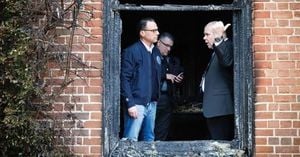With winter just around the corner, it's time to think about winterizing your home. The City of Sioux City, Iowa, has shared practical tips for homeowners to protect against the biting cold and soaring heating costs.
First things first, homeowners are encouraged to inspect and insulate their windows and doors. Ensuring these are sealed tightly is key to preventing heat loss. If the weather stripping around your doors or windows is worn, replacing it can significantly improve energy efficiency. An added layer of protection could be installing plastic film insulation on the windows, which acts as a barrier against frosty drafts.
Next on the list is checking heating systems. It's wise to get your furnace or heating system professionally serviced. A seasonally tuned-up system ensures it runs efficiently and effectively when you need it most. Replacing filters and making sure thermostats are calibrated correctly is also advised for optimal performance.
Homeowners should also focus on sealing gaps and cracks. This can be done using caulk or spray foam around windows, doors, and vents, which can prevent unwanted drafts. No one wants to feel the chill of winter creeping through their walls!
Insulating pipes is another proactive measure to stave off winter woes. Foam pipe insulation or heat tape can be used, especially in those chilly areas of the house like basements, crawl spaces, and attics. It’s simple but could save you from major headaches — and repair bills — from burst pipes.
And don’t forget about those kitchen and bathroom cabinet doors. By leaving these open, warmth can circulate around plumbing, reducing the chances of freezing. Be sure to familiarize yourself with your home's water shut-off valve and keep water dripping from faucets during extremely cold temperatures.
Cleaning and maintaining gutters is equally important. If gutters are clogged, melting snow and ice can cause back-ups and eventually lead to water damage. Consider investing in gutter guards to keep them clear during winter.
The condition of your roof should not be overlooked either. Heavy snow and ice can lead to dangerous conditions, so inspect it for any wear or loose shingles. It's also important to clear chimneys of debris to avoid fire hazards.
Don't forget about insulation, especially in the attic and basement. Extra insulation can make all the difference between staying cozy and freezing during those cold months.
Outdoor preparations are just as necessary. Drain and disconnect hoses from outdoor faucets and don’t forget to winterize your sprinkler system. Cover any outdoor furniture and trim any trees or branches, especially those close to your home, which could be hazardous during snowstorms.
Safety is also key as heating systems are used more. Therefore, testing smoke and carbon monoxide detectors should be part of your winter prep checklist. Regular checks and battery replacements will help keep risks at bay.
Finally, stocking up on winter supplies is always smart. Gather essentials such as bottled water, non-perishable food, blankets, flashlights, batteries, and even first aid kits just in case of power outages or emergencies.
Meanwhile, as you prepare your home, it’s also important to set your thermostat correctly during winter. Experts suggest maintaining your thermostat at about 68 degrees Fahrenheit (20 degrees Celsius). Not only does this provide comfort, but it also mitigates issues like mold and dampness.
According to Shu Saito, an HVAC expert, keeping the temperature stable helps prevent humidity fluctuations. “Keeping your thermostat at a consistent temperature prevents humidity fluctuations, which can lead to condensation and mold growth,” he states. This advice aligns with findings from heating specialists who argue stability is key during colder months.
So what’s the best temperature for optimal home health? Experts recommend keeping the thermostat between 68°F and 72°F for maximum comfort and energy efficiency. This number strikes the right balance, helping to prevent those pesky moisture problems associated with colder surfaces.
One tip from Shu is to invest in high-quality filters for your HVAC system. “A clean filter will help maintain good airflow,” he notes, emphasizing how dirty filters force your heating system to work overtime, leading to higher energy bills.
But what if you’re not home during the day? Should you maintain the same temperature? The answer is no. Experts suggest lowering the thermostat to around 55°F (13°C) to save energy without compromising safety. For those who are tech-savvy, programmable or smart thermostats can optimize heating schedules based on your routine, enhancing both convenience and sustainability efforts.
To sum it up, getting ready for winter is more than just shoveling snow. Proper preparation can safeguard your home, ensuring warmth and comfort without breaking the bank. With these tips from Sioux City and HVAC experts, you're well on your way to creating a winter-ready haven.
Whether you're covering your outdoor furniture or checking your heating system, being proactive will save you from reactive approaches when the cold snaps hit. So, bundle up and start checking off your winterization list today!
Remember, taking these steps not only protects your home — it might also keep your wallet feeling healthy this winter season.



